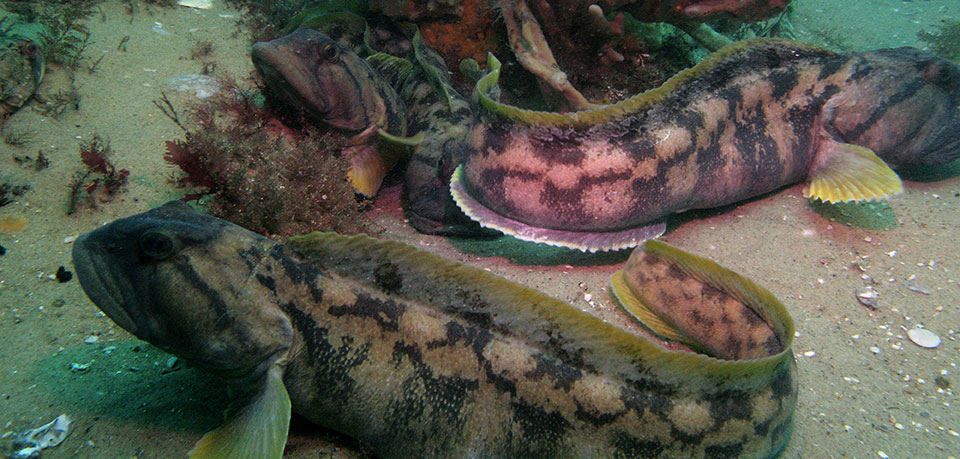Fishing Impacts
Stellwagen Bank

Why is it a concern?
Stressors resulting from commercial fishing include alteration of habitat, removal of biomass, discharge of pollutants, entanglement of marine mammals, and destruction of historic resources. Fishing with mobile gear such as trawls, scallop dredges, and clam dredges, together with fixed gear such as bottom-tending gillnets and lobster pots, occurs extensively throughout the sanctuary. Commercial fishermen take species from four principal categories: groundfish, pelagics, other finfish and invertebrates. Approximately 440 commercial fishing vessels fish in the sanctuary every year (vessel trip report analyses, SBNMS unpublished).
In a study using a 25-year trawl time series (1970-1994), Auster (2002) found that while the effects of exploitation of fish populations did not result in local extinctions, there were significant declines in a range of diversity metrics that take both species richness and abundance into account and that can be attributed to extensive exploitation of dominant species and bycatch mortality of species of lower abundance and of little economic value. NOAA National Marine Fisheries Service research trawl data (1963-2000) from within sanctuary boundaries have been analyzed to determine the effects of fishing on fish size and structure. All of the species examined showed decreasing trends in maximum length over the 37-year period. The selective removal of top predators in large numbers by commercial and recreational fishing has been shown to have cascading effects on trophic dynamics that reduces ecological integrity. Finally, research is being done on the status of sand lance, which is a key species within the sanctuary and serves as the primary prey of humpback whales. Sand lance availability is largely dependent on environmental conditions and predator-prey interactions, which can be highly variable and difficult to predict.
Overview of Research
Past and current research in Stellwagen Bank National Marine Sanctuary has focused on characterization of fish assemblages in different benthic communities.
| Project Name | PI and contacts | Links |
|---|---|---|
Movement of Atlantic Cod |
SBNMS, PIER, NURC-UCONN |
Science Needs and Questions
- What is the minimum exclusion zone needed around a maritime heritage resource to prevent impacts from traditional fishing activities?
- How do impacts to maritime heritage resources from traditional fishing activities vary based upon vessel size and gear types?
- Does notification of maritime heritage resource site locations reduce fishing gear impacts?

References
Auster, P.J. 2002. Representation of biological diversity of the Gulf of Maine region at Stellwagen Bank National Marine Sanctuary (Northwest Atlantic): patterns of fish diversity and assemblage composition. p. 1096-1125. Managing Protected Areas in a Changing World. S. Bondrup-Nielson, T. Herman, N.W.P. Munro, G. Nelson and J.H.M. Willison (eds.). Science and Management of Protected Areas Association, Wolfville, Nova Scotia.
Frank et al. 2005. Trophic Cascades in a Formerly Cod-Dominated Ecosystem. Science 308: 1621–1623.
Jackson et al. 2001. Historical Overfishing and the Recent Collapse of Coastal Ecosystems. Science 293: 629-637.
Office of National Marine Sanctuaries. 2008. Stellwagen Bank National Marine Sanctuary Condition Report 2008. U.S. Department of Commerce, National Oceanic and Atmospheric Administration, Office of National Marine Sanctuaries, Silver Spring, MD. 39 pp.
Office of National Marine Sanctuaries. 2010. Stellwagen Bank Science Fishing Impacts to Maritime Heritage Resources U.S. Department of Commerce, National Oceanic and Atmospheric Administration, Office of National Marine Sanctuaries, Silver Spring, MD, Accessed: 7/22/2014
Steneck et al. 2004. Accelerating Trophic-level Dysfunction in Kelp Forest Ecosystems of the
Western North Atlantic. Ecosystems 7:323–332.

